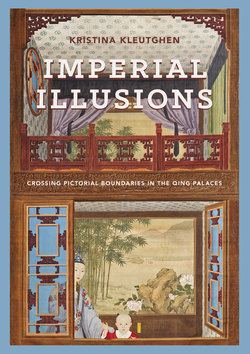Читать книгу Imperial Illusions - Kristina Kleutghen - Страница 16
На сайте Литреса книга снята с продажи.
Оглавлениеeighteenth-century Beijing. Today only a handful of those that Qianlong commissioned remain to testify to the scenic illusion phenomenon at the Qing court. More may come to light in the future, but for now, only five single paintings and one complete interior program remain in situ; four paintings survive outside their original architectural contexts; and there is visual evidence for three works that have not survived. Now held almost exclusively inside restricted areas of the Palace Museum, three of the extant single scenic illusions were briefly displayed internationally,6 but upon their return to Beijing became just as inaccessible as before. The unwieldiness and fragility of these massive paintings severely complicate their handling, photography, and display, consequently circumscribing even scholarly access, and there have been correspondingly few publications.7 In spite of their current rarity and their historical, historiographical, and institutional invisibility, scenic illusion paintings offer new insights into late imperial China’s most influential emperor. More importantly, however, they also provide a new perspective on how Chinese art integrated or rejected foreign concepts during the height of early modern Sino-European exchange.
Approaching Scenic Illusion Paintings
“Scenic illusion painting” is a connotative translation of tongjinghua, the functionally elegant Chinese term that describes the viewer’s experience of these paintings: the term literally means “to connect, cross into, or move through” (tong) “scenes” (jing) that are “painted” (hua). Although this was the most common term, many others were used and could even designate the same painting over the course of its production, including “deep-distance paintings” (shenyuanhua), “perspectival paintings” (xianfahua, literally “line-method paintings”), “scenic illusion perspectival paintings” (tongjing xianfahua), and “scenic illusion oil paintings” (tongjing youhua). Translating tongjinghua both into English and into concise, modern art-historical terminology has proven difficult, resulting in renderings as varied as “panoramic perspective scene” and “illusionistic murals.”8 It is most often rendered as “trompe l’œil” (tricks the eye), the anachronistic, culturally distant, and heavily weighted Western term now indiscriminately used to designate nearly all illusionistic paintings. Although the Western tradition of pictorial illusionism famously began with the competition between the Greek painters Zeuxis (act. 435–390 BCE) and Parrhasius (act. 440–390 BCE), vividly described by Pliny the Elder (23–79 CE) in his Natural History (c. 77–79 CE), “trompe l’œil” appeared as a noun only around 1800 to denote a specifically French genre of ultrarealistic, self-contained, framed still-life easel painting.9 Quadratura, the perspectival Renaissance and Baroque wall and ceiling paintings that rely on visual contiguity between painting and architecture to create the illusion of real, permeable space,10 played an important role in the development of scenic illusions. But the concept of “moving through scenes” (tongjing) originated about half a millennium earlier in the Yuan dynasty, when tongjinghua described landscape paintings with a high isometric
